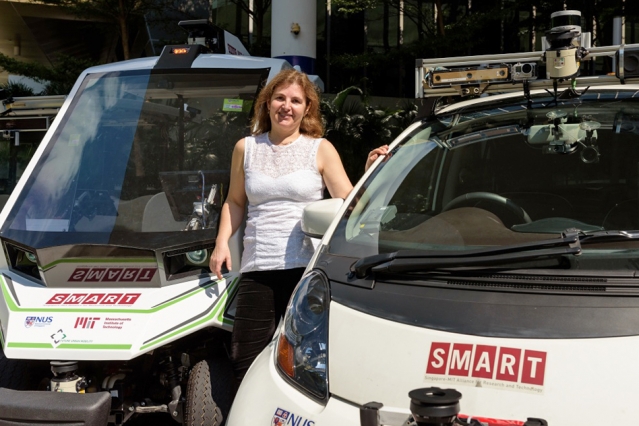
Robohub.org
Combining automation and mobility to create a smarter world
By: Catherine Marguerite | Singapore-MIT Alliance for Research and Technology
Daniela Rus loves Singapore. As the MIT professor sits down in her Frank Gehry-designed office in Cambridge, Massachusetts, to talk about her research conducted in Singapore, her face starts to relax in a big smile.
Her story with Singapore started in the summer of 2010, when she made her first visit to one of the most futuristic and forward-looking cities in the world. “It was love at first sight,” says the Andrew (1956) and Erna Viterbi Professor of Electrical Engineering and Computer Science and the director of MIT’s Computer Science and Artificial Intelligence Laboratory (CSAIL). That summer, she came to Singapore to join the Singapore-MIT Alliance for Research and Technology (SMART) as the first principal investigator in residence for the Future of Urban Mobility Research Program.
“In 2010, nobody was talking about autonomous driving. We were pioneers in developing and deploying the first mobility on demand for people with self-driving golf buggies,” says Rus. “And look where we stand today! Every single car maker is investing millions of dollars to advance autonomous driving. Singapore did not hesitate to provide us, at an early stage, with all the financial, logistical, and transportation resources to facilitate our work.”
Since her first visit, Rus has returned each year to follow up on the research, and has been involved in leading revolutionary projects for the future of urban mobility. “Our team worked tremendously hard on self-driving technologies, and we are now presenting a wide range of different devices that allow autonomous and secure mobility,” she says. “Our objective today is to make taking a driverless car for a spin as easy as programming a smartphone. A simple interaction between the human and machine will provide a transportation butler.”
The first mobility devices her team worked on were self-driving golf buggies. Two years ago, these buggies advanced to a point where the group decided to open them to the public in a trial that lasted one week at the Chinese Gardens, an idea facilitated by Singapore’s Land and Transportation Agency (LTA). Over the course of a week, more than 500 people booked rides from the comfort of their homes and came to the Chinese Gardens at the designated time and spot to experience mobility-on-demand with robots.
The test was conducted around winding paths trafficked by pedestrians, bicyclists, and the occasional monitor lizard. The experiments also tested an online booking system that enabled visitors to schedule pickups and drop-offs around the garden, automatically routing and redeploying the vehicles to accommodate all the requests. The public’s response was joyful and positive, and this brought the team renewed enthusiasm to take the technology to the next level.
Since the Chinese Gardens public trial, the autonomous car group has introduced a few other self-driving vehicles: a self-driving city car, and two personal mobility robots, a self-driving scooter and a self-driving wheelchair. Each of these vehicles was created in three phases: In the first phase, the vehicle was converted to drive-by-wire control, which allows a computer to control acceleration, braking, and steering of the car. In the second phase, the vehicle drives on each of the pathways in its operation environment and makes a map using features detected by the sensors. In the third phase, the vehicle uses the map to compute a path from the customer’s pick-up point to the customer’s drop-off point and proceeds to drive along the path, localizing continuously and avoiding any other cars, people, and unexpected obstacles. The devices also used traffic data from LTA to model traffic patterns and to study the benefits of ride-sharing systems.
Last April, the team conducted a new test with the public at MIT. This time, they deployed a self-driving scooter that allowed users to use the same autonomy system indoors as well as outdoors. The trial included autonomous rides in MIT’s Infinite Corridor. A significant challenge in this type of space is localization, or accurately knowing the location of the robot in a long and plain corridor that does not have many distinctive features. The system proved to work very well in this type of environment, and the trial completed the demonstration of a comprehensive uniform autonomous mobility system.
“One can easily see the usefulness of such a system between self-driving city cars, golf buggies, and scooters,” Rus says. “A mobility-impaired user could, for example, use a self-driving scooter to get down the hall and through the lobby of an apartment building, take a self-driving golf buggy across the building’s parking lot, and pick up an autonomous car on the public roads to go to a similarly equipped amusement park or shopping centre.”
Daniela Rus, a Class of 2002 MacArthur Fellow and member of the USA National Academy of Engineering, knows that each successful step into urban mobility will bring a positive contribution of artificial intelligence to the public. According to the World Health Organization, 3,400 people die each day in the world from traffic-related accidents.
“It is a new space race,” she says, convinced that autonomy is part of the solution to safe transportation. Daniela Rus will continue visiting her beloved Singapore, where she particularly enjoys the food, the beautiful flowers, the kindness of its people, and the smartness of its youth. “Singapore is definitely a model in many fields,” she concludes.
tags: Automation, Automotive, autonomous vehicles, Daniela Rus, LIDAR, MIT, robohub focus on autonomous driving




